4 Important Things Every Male Poler Should Know
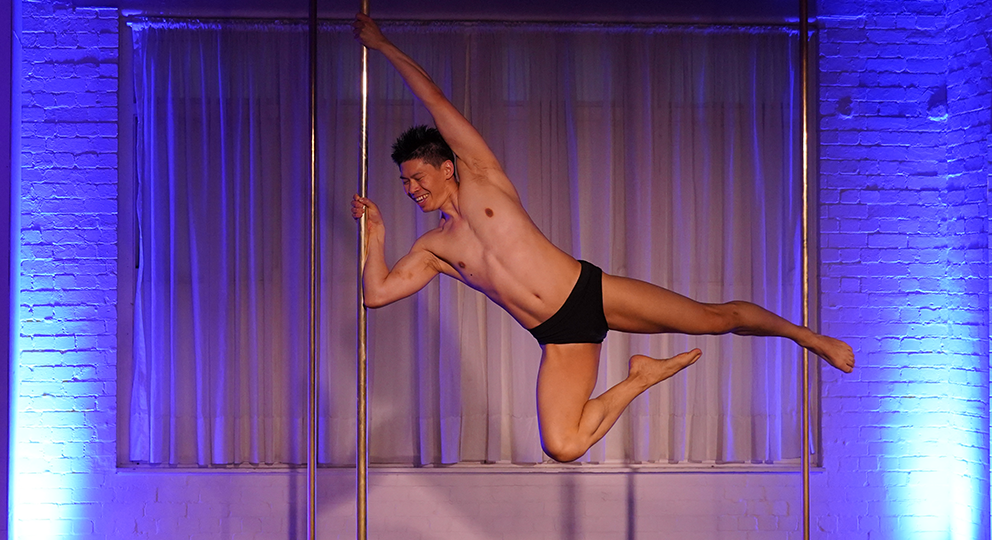
Long before I discovered the amazing world of pole dance, I enjoyed a career as a professional dancer. While this experience has been a huge benefit throughout my pole journey, there are plenty of “male-specific” lessons I’ve had to learn along the way. Some were painful, and some were downright hilarious.
Thanks to the ever-increasing popularity of pole dance around the world, what was once a female-dominated sport is constantly evolving as more and more men discover and fall in love with pole.
Despite this, there is very little info out there for male pole dancers.
I’d like to do something to help change this, and that is why I’ve written this blog.
Whether you are brand new to pole or have years of experience, I hope the following information is of benefit to either you or another male poler you know.
So without further ado, let’s dive into what I believe are the four most important topics male polers should know about. Starting with...
THE DANCE BELT: WHAT IS IT?
A dance belt is a specialised undergarment originally created for male ballet dancers in the early 1900s. Designed to be “invisible” when worn under white or light-coloured tights, dance belts are essentially “industrial strength” G-strings that serve two main purposes:
1. They keep the crown jewels supported and protected
2. They disguise any lumps and bumps to create a smooth aesthetic.
When dancers perform grand leaps, intricate leg work, and pas de deux – that's a fancy ballet phrase for partner work ![]() – there is a very real chance of injury if any “bits and pieces” aren’t securely held in place. Dance belts provide support and protection by keeping everything safely compressed against the body, allowing dancers to move freely without the worry of things moving around or getting in the way.
– there is a very real chance of injury if any “bits and pieces” aren’t securely held in place. Dance belts provide support and protection by keeping everything safely compressed against the body, allowing dancers to move freely without the worry of things moving around or getting in the way.
While there are full-seat dance belts available, the G-string is the original and most functional design as it allows the hips and glutes to move freely without excess fabric bunching or getting in the way.
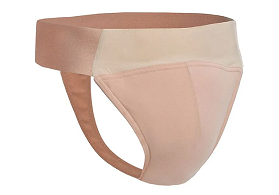
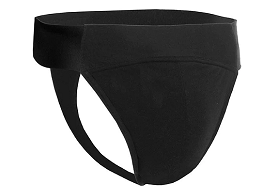
Why should male polers wear one?
First and foremost, for SAFETY! We already have a LOT to think about while we move around on the pole. Removing this element of concern allows us to focus on the more important safety aspects as well as our ability to perform. By keeping everything securely in place we also minimise the possibility of injury when executing skills and transitions that involve upper thigh grip. If you've ever done a Superman, or any skill that requires a hip hold for that matter, then you know exactly what I mean.
There are also visual benefits to consider. Unlike regular underwear, the front pouch of a dance belt is slightly padded. Not only does this disguise any discernable details, but with everything supported and held neatly in place, the overall size of the package is also *ahem* enhanced. And let’s be honest, who doesn't want that?
No matter where you are in your pole journey, a dance belt should be a staple in every male poler's wardrobe.
THE HIP HOLD: WHAT GOES WHERE?
One of the first real “owie” grips most polers learn is the hip hold. This grip is used in a variety of skills, both upright and inverted, and whilst it can be painful and confronting at first, it will quickly become a comfortable "rest" position. Understanding what goes where is vital to prevent any unnecessary pain or injuries.
When performing a hip hold, we want to make sure the pole is positioned at the very top of our thigh in the hip crease, where the leg bends at the hip. We also need to make sure that the pole is sitting in the correct hip crease for the specific skill we are going to perform.
Let’s have a look at the thigh hold/pole sit as an example.
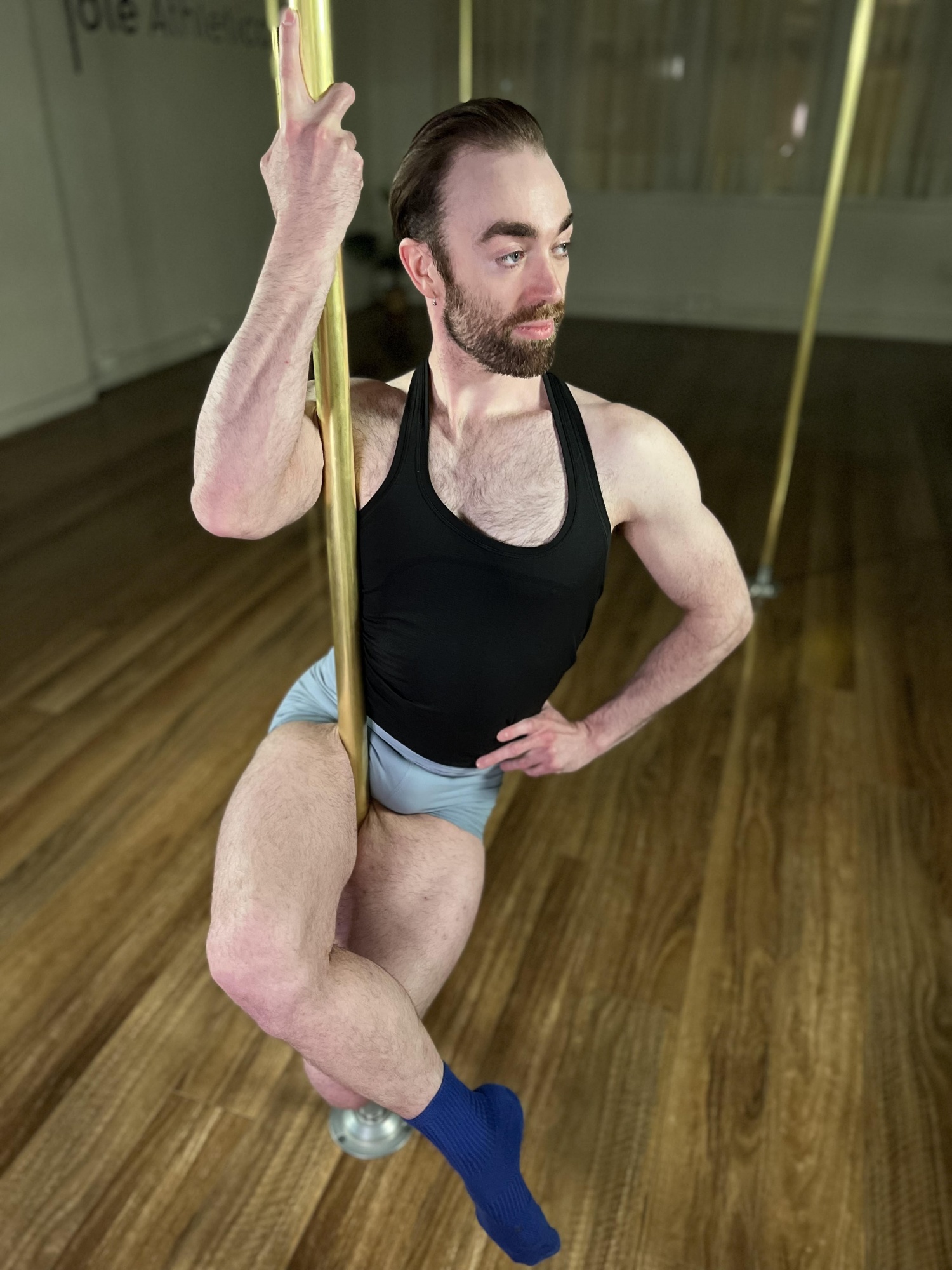
As you can see, the pole is sitting securely in the hip crease of the top hip with everything else positioned on the opposite side of the pole.
Why the top hip? When we hitch our hip, the pole presses into the thigh/hip crease of the hitched hip to create a lock. If the pole is positioned in our bottom hip and we try to hitch the top hip, we’d be in a world of pain as very sensitive body parts would be squashed against the pole.
This is also a great example of why wearing a dance belt is extremely beneficial. Everything is kept safely contained so we don’t have to worry about anything getting in the way while we focus on executing a skill.
OOOOOOOH THAT HURTS: WORKING THROUGH THE PAIN
While I firmly believe that anyone can pole, it is definitely not for the faint-hearted. Pole is a mentally and physically challenging sport that requires you to develop an ever-evolving mind-body connection. And to be completely honest, some skills are pretty painful at first.
Think about it: You’re placing a thin metal object into strange places and asking sensitive skin to hold your body weight while you point your toes, smile, and try to make amazing skills and tricks look effortless.

Unfortunately, there is no magical shortcut to desensitising your skin. The only way to get past the pain is to work through it, and this is where practice comes in.
What happens when you desensitise your skin?
Pain is a fight or flight reaction and is our body's way of protecting itself. When we desensitise our skin, we are conditioning our nerve endings to understand that what we are doing is okay and we're not in any danger.
The more time you can spend on the pole the better. If a skill feels too difficult, break it down into bite-size chunks to give your body time to adapt. Before you know it, the skill will no longer hurt and you’ll be ready to take on your next big challenge.
Try this: Hold a skill for 3 seconds, then try the other side. Next time aim to hold the skill for 5 seconds, then 8, and so on. This progressive approach gives your skin time to get used to the skill gradually.
Another great tip is to use your breath. Consciously taking deep, slow, calm breaths while holding a skill will help your nervous system remain calm and allow it to adapt faster.
Whilst your muscles need to remain active whenever you perform a skill, make sure you don't over-squeeze them as this can create unnecessary pain. Finding a comfortable balance of muscle activation and passive skin grip will make a huge difference in your comfort levels and endurance on the pole.
Some skills will become "rest" positions and feel comfortable, and some skills may always have an element of discomfort or sensitivity. Over time our bodies adapt and understand that this is an acceptable level of pain and we are safe.
Everyone's level of pain tolerance is different. Some body parts can take longer to desensitise than others. My best advice is to listen to your body and be consistent. You’ll get there.
BODY HAIR: IT'S A PERSONAL CHOICE
When it comes to body hair and our desired aesthetic, everyone is different. Some men prefer to be smooth and remove their body hair completely, while others prefer to let mother nature do her thing and go au natural.
No matter your preference, when it comes to pole there’s more to consider than how we look. Body hair can create extra hurdles, especially for pole newbies, that can potentially hinder your pole journey.
As you progress through your pole journey, more and more of your body will be used to grip the pole in ways you never thought possible. Body hair can add an extra element of pain to the mix that can be easily fixed.
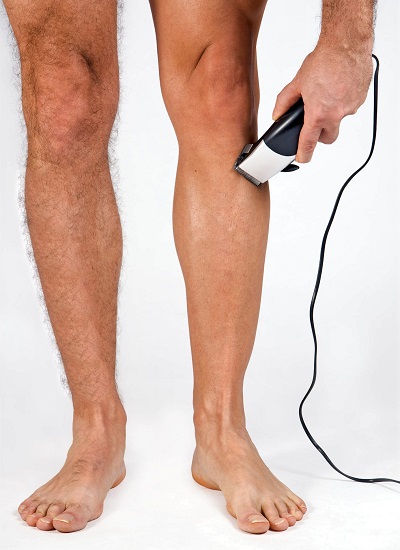
Here are the three biggest factors to think about when it comes to body hair:
Body hair traps sweat
Generally speaking, men tend to sweat more than women do. In the pole world, sweat can be the kiss of death as it makes gripping the pole immensely difficult, if not impossible.
If you’d prefer to keep your body hair intact, I highly recommend keeping a hand towel with you during class to wipe away any excess sweat. Please also make sure you clean your pole after class or practice sessions to ensure that it’s clean and sweat-free for the next person.
Body hair can hurt!
Body hair can make certain skills more painful as it feels like your hair is being ripped out of the skin. If you’re really attached to your body hair, strategic hair removal might be the way to go. Trimming the hair in regularly used grip points like your inner thighs and behind your knees can help reduce pain without the need to remove all of your hair.
Body hair can prevent friction
Whenever we grip the pole we rely on friction to keep us in the air. Body hair can reduce, or even prevent the necessary friction from being created. In response to this, we can over-squeeze our muscles as we try to hang on which can lead to possible muscular fatigue, strain, or even bigger injuries.
My advice? Get rid of it! Or at least keep it trimmed. Unless having body hair is a solid part of your identity, I recommend removing as much of it as possible. How you do it is entirely up to you.
If you have sensitive skin or thick, coarse body hair then I recommend trimming with clippers instead of shaving. Shaving can create skin irritation and lead to ingrown hairs, which can be painful even when you're not on the pole.
Everyone’s hair and skin types are different, so you’ll need to figure out what works best for you.
I hope I've helped answer some of the bigger questions male polers face, especially at the start of their journey.

Shea
PA Studio Manager
